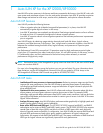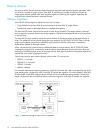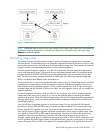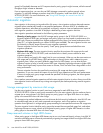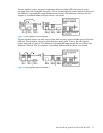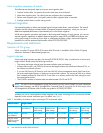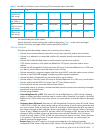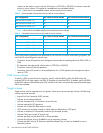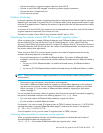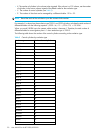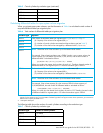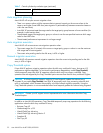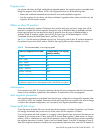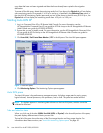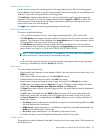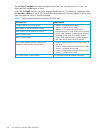
Auto LUN XP user guide for the XP12000/XP10000 19
• Volumes reserved by a migration program other than Auto LUN XP
• Volumes on which the RAID Manager is performing volume migration operations.
• Volumes that form a Snapshot XP pair.
• Virtual and pool volumes.
Number of volumes
In manual migrations, the number of migration plans that can be executed concurrently might be restricted,
depending on use of other Command View XP or XP Remote Web Console programs and emulation types
and sizes of migrated volumes. Therefore, the number of migration plans that can be executed concurrently
is not constant.
A maximum of 36 Auto LUN XP copy operations can be requested at the same time. Auto LUN XP performs
migration operations sequentially (one volume at a time).
The maximum number of Auto LUN XP copy operations plus BC pairs is 1024.
Calculating the number of Auto LUN XP concurrent migration plans
When a migration plan is created, differential tables are used. Differential tables are disk array resources
that are shared by Flex Copy XP, Business Copy XP, ShadowImage for z/OS
®
, Hitachi FlashCopy
Mirroring, Hitachi FlashCopy Mirroring Version2, Snapshot XP, and Auto LUN XP. The maximum number of
differential tables that Auto LUN XP can use is the number of total differential tables in the disk array minus
the number used by other applications.
When using Auto LUN XP for manual volume migration, the number of migration plans that can be
executed concurrently depends on the following:
• How much shared memory is available for differential tables. The number of differential tables
available in one disk array is determined by whether additional shared memory for differential tables is
installed.
• You can use 13,652 differential tables if no additional shared memory for differential tables is
installed.
• You can use 30,718 differential tables if additional shared memory for differential tables is installed.
NOTE: Contact your HP account support representative for more information about adding additional
shared memory.
• The emulation type and capacity of each volume to be migrated:
The number of differential tables needed to migrate one volume differs depending on the emulation
type and size of the volume. For the number of differential tables needed for migrating a mainframe
volume, see page 19. For the number of differential tables needed for migrating an open-system
volume, see page 21.
You can estimate the maximum number of migration plans that can be executed concurrently by applying
the previously described conditions to the following equation: , where:
• Σ(α) is the total number of differential tables needed to migrate all volumes.
• (β) is the number of available differential tables.
For example, if you want to create 20 migration plans of OPEN-3 volumes (volume size = 2,403,360 KB),
calculate the number of required differential tables (page 21) and enter this number in the equation:
.
Since this equation is true, you can create 20 migration plans of OPEN-3 volumes.
Calculating differential tables for mainframe volume migration
When you migrate mainframe volumes, use the following equation to calculate the total number of
required differential tables per migration plan:
, where:
Σα() β()=
120
×()20=[]13,652 or 30,718≤
XY+()15× Z÷ Total number of differential tables per migration plan=



